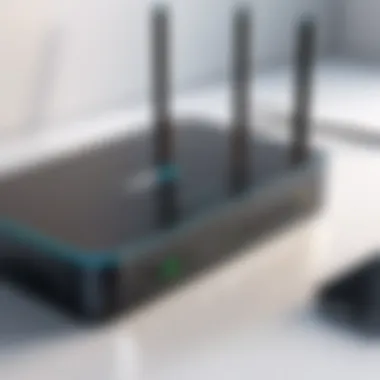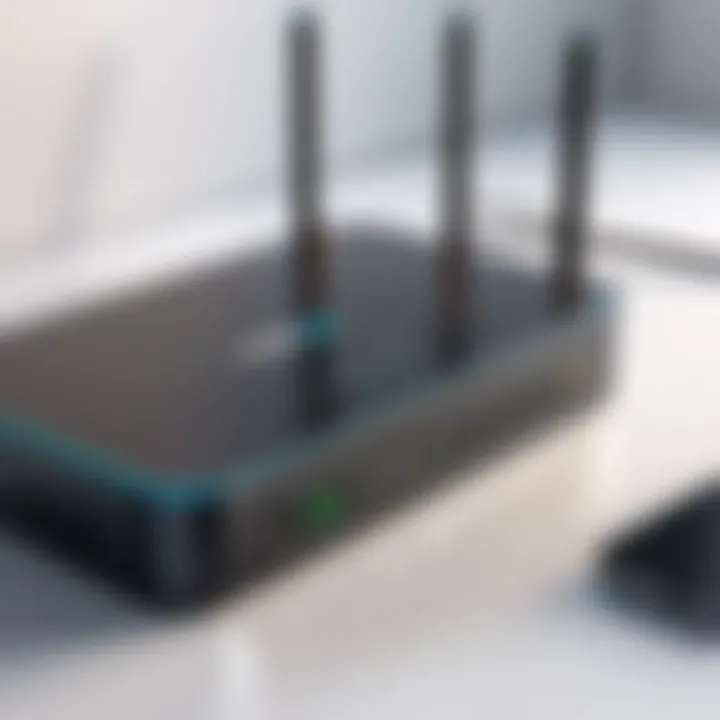Key Components for Setting Up Your VPN Successfully


Intro
Establishing a Virtual Private Network (VPN) requires a nuanced understanding of several components. As cyber threats evolve and digital landscapes become more complex, understanding the essentials of VPN setup can significantly enhance security and privacy.
This section outlines the vital components involved in setting up a VPN. From the requisite hardware and software elements to the security protocols necessary for effective operation, we will review each aspect in detail. Besides, it is essential to consider user needs in both personal and business contexts when creating an effective VPN solution. This approach ensures a robust strategy for protecting data and maintaining a secure online presence.
Cybersecurity Threats and Trends
In today's digital age, cybersecurity threats are a pervasive reality that individuals and organizations must address effectively. By identifying these threats, users can better understand the imperative need for a VPN.
Notable cybersecurity threats in the digital landscape
Modern threats include malicious software, data breaches, and man-in-the-middle attacks. Attackers leverage sophisticated tactics to gain unauthorized access to sensitive information, making it imperative for users to adopt robust security measures like VPNs.
Emerging trends in cyber attacks and vulnerabilities
Cybercriminals are increasingly using advanced technologies such as artificial intelligence to enhance the efficiency of their attacks. Credential stuffing and ransomware are gaining wider applicability, revealing vulnerabilities in standard security setups which makes VPN usage more relevant.
Impact of cyber threats on individuals and businesses
For individuals, breaches can lead to identity theft and privacy violations, while organizations could suffer severe financial losses and reputational damage. Implementing strong cybersecurity measures, including VPNs, is crucial for safeguarding personal and corporate data.
Best Practices for Cybersecurity
Establishing a VPN is just one part of a comprehensive cybersecurity strategy. To be effective, consider integrating best practices into your routine.
Importance of strong password management
Passwords form the first line of defense in online security. Utilizing strong, unique passwords reduces the likelihood of unauthorized access.
Implementing multi-factor authentication for enhanced security
Multi-factor authentication adds another layer of security, requiring additional identification proofs, thereby protecting accounts even if passwords are compromised.
Regular software updates and patches for protection
Keeping software updated closes vulnerabilities that can be exploited by attackers. Regular updates must include VPN software and device operating systems.
Secure online browsing habits and email practices
Awareness of phishing attempts in email and links can prevent malware installation. Secure browsing practices, such as avoiding insecure sites, should be the norm.
Privacy and Data Protection
A Reliable VPN aids in securing privacy as it encrypts internet traffic, a vital consideration in protecting personal data.
Importance of data encryption for privacy
Encryption transforms data into unreadable formats, allowing only authorized access which is crucial in preventing unauthorized data interception.
Risks associated with sharing personal information online
The dangers tied to sharing sensitive information underscore the urgency for implementing security measures like using a VPN. Sharing too much can lead to data exploitation.
Strategies for safeguarding sensitive data and personal details
Utilize data anonymization practices and apply restrictions on data sharing across platforms to reduce exposure. Using a VPN adds an additional privacy layer in this effort.
Security Technologies and Tools
An array of tools supplement VPNs, enhancing security further while browsing online.
Overview of key cybersecurity tools and software
Besides VPNs, firewalls, antivirus programming, and password managers play a crucial role in a comprehensive security strategy.
Benefits of using antivirus programs and firewalls
Antivirus programs can detect problematic files before they compromise systems, while firewalls monitor traffic entering and exiting devices to block potential threats.
Application of Virtual Private Networks (VPNs) for secure data transmission


VPNs encrypt data, making it difficult for attackers to intercept and analyze transmitted information.
Cybersecurity Awareness and Education
Elevating awareness is critical as the threat landscape continues to evolve.
Educating individuals on recognizing phishing attempts
Learning how to identify phishing scams equips users to better protect their personal information while online.
Promoting cybersecurity awareness in the digital age
Awareness campaigns targeting both businesses and individuals can fortify community resilience against cyber threats.
Resources for learning about cybersecurity fundamentals
Various online resources offer insights into cybersecurity basics, ideal for users and organizations aiming to improve security proficiency. Consider checking organizations or link sources such as en.wikipedia.org for foundational knowledge.
A well-planned VPN setup not only safeguards sensitive data but also plays a critical role in fighting against the growing prevalence of cyber threats in our interconnected world.
Understanding VPN Technology
VPN technology is crucial for establishing secure connections, whether for business or personal use. Understanding its core components gives clarity on how data can be securely transported over the internet. When using a VPN, all data that travels from a device is encrypted and goes through a secure tunnel. This means even if the data is intercepted, it cannot be read.
Furthermore, having knowledge of different aspects of VPN technology helps users select the most appropriate solution for their needs. A deep comprehension ensures optimal performance and helps in detecting any potential issues in the setup.
What is a VPN?
A Virtual Private Network (VPN) is a service that creates a secure connection over the internet. It extends a private network across a public network, enabling users to send and receive data as if their computing devices were directly connected to the private network. In essence, a VPN can mask the user's IP address, making their online actions virtually untraceable.
The primary function of a VPN is to enhance privacy and security. By using a VPN, users can access restricted content, avoid censorship, and protect their sensitive data from potential attacks.
How VPNs Work
VPNs operate by routing the user's computer through a remote server owned by the VPN provider. This process involves encapsulating the user's data within layers of encryption, making sync'd information less vulnerable to interception.
- Encryption: The data the user sends is encrypted before is leaves their device, making it unreadable to anyone without the proper key.
- Tunneling: The encrypted data travels through a tunnel, preventing outsiders from accessing the raw data.
- Decryption: Once the data reaches its destination, it is decrypted, allowing the final service to access the information securely.
Types of VPNs
Knowledge of the various types of VPNs aids in the understanding of their usage and technical demands. Each type serves different environments with unique requirements.
Remote Access VPN
Remote access VPN allows users to connect to a private network from a remote location. Employees can access company resources from anywhere in the world using an encrypted connection. The ease of use makes it a popular choice among professionals working from home or on travel.
- Key Characteristic: Users gain access to their private networks without being physically present.
- Unique Feature: Connection is established usually through dedicated software or applications provided by the VPN service.
- Advantages: Offers flexibility and remote access without security compromising.
- Disadvantages: Relies heavily on the user’s internet speed; interruptions occur if the connection drops.
Site-to-Site VPN
Site-to-Site VPN is utilized primarily by businesses. It connects entire networks to each other and does not require individual device installation or configuration.
- Key Characteristic: Enables connection between two offices, enhancing the internal communications.
- Unique Feature: Data travel is encrypted across secure connections between sites without the need for a user’s intervention.
- Advantages: All devices connected to the network benefit without installing extra software.
- Disadvantages: Complicated and often needs higher setup costs due to dedicated hardware.
Cloud VPN
Cloud VPN leverages cloud technology and is typically used by modern enterprises with remote workers. The essence of its structure emphasizes a pay-per-use or subscription model for secure networking services.
- Key Characteristic: The VPN service is hosted in the cloud rather than on traditional infrastructure like dedicated hardware.
- Unique Feature: More scalable than traditional VPNs, offering flexibility in response to changing business needs.
- Advantages: Cost-effective for businesses that need to support various users without overwhelming IT resources.
- Disadvantages: Some users claim it can lead to reduced control over data since it largely depends on service providers' security measures.
Understanding the different types of VPN is fundamental for selecting the right solution for enhanced security and connectivity.
Hardware Requirements
Understanding the hardware requirements for setting up a Virtual Private Network (VPN) is crucial. The right hardware plays an essential role in determining the efficiency and reliability of a VPN service. Each component must work harmoniously to deliver optimal performance. If any part underperforms, the VPN may suffer from latency, reliability issues, or inadequate security. Thus, a comprehensive overview of the hardware requirements is vital for both personal users and enterprises.
Router Specifications
When choosing a router for VPN usage, specifications matter significantly. Not all routers support VPNs in the same way. It’s critical to look at processing power and memory. A router with a faster processor can handle encryption tasks better. This means better speeds and fewer dropped connections.
Additionally, finding routers that can configure with your desired VPN protocols is imperative. Routers that support protocols like OpenVPN or IPSec are preferred. Basic routers might fall short in these areas and lead to suboptimal VPN performances.
For example, a commonly recommended router is the ASUS RT-AX88U. This model supports high-speed connections and can easily manage multiple VPN connections without dragging down internet speeds.


Computer and Mobile Device Capabilities
Computer and mobile device performance is also vital for VPN function. When selecting devices, it's essential to ensure they have the required specifications to handle the encryption processes required by VPNs. A device equipped with sufficient RAM and a competent CPU tends to run VPN applications more effectively. Insufficient resources could cause slowdown and system instability.
Moreover, check compatibility with multiple operating systems. Devices that support Windows, macOS, Linux, iOS, and Android qualify better. This flexibility allows users to connect various devices.
Server Infrastructure for Enterprise Solutions
For larger organizations, a robust server infrastructure is paramount. Companies often set up dedicated VPN servers to increase security and manage traffic. These servers need to be secured properly and configured to handle many user connections simultaneously. Hardware should support AMD or Intel architecture, offering scalable performance. Additionally, storage solutions linking those servers to keep logs, configurations, and user data can be optimized using RAID configurations for stability.
VPN performance experience relies heavily on the availability of in-house or cloud resources. Building a VPN centered around specific business needs often means investing in dedicated hardware solutions, like the Dell PowerEdge or HP ProLiant servers, tailored for enterprise safety.
Software Essentials
Software components play a vital role in setting up a VPN. They ensure that data is transmitted securely and efficiently. Various software options exist to cater to different needs. It is crucial to consider compatibility and functionality when choosing software components to facilitate a robust VPN. The right software not only enhances security but also improves user experience.
Choosing a VPN Service Provider
Choosing a VPN service provider is a fundamental step. It involves selecting a vendor that meets specific needs, whether for personal use or enterprise deployment. Users must consider factors such as logs policy, privacy standards, and connection stability. A no-logs policy signifies that the provider does not monitor or save users' activities, promoting increased privacy. Moreover, intentions behind usage ultimately determine the best choice.
Open-source VPN Software Options
Open-source software options provide flexibility and often come without licenses costs, making them popular choices among IT professionals.
OpenVPN
OpenVPN is a widely adopted open-source software that provides secure communication. Its key characteristic is the ability to configure complex setups leveraging SSL/TLS for encryption. OpenVPN frequently stands out for its versatility across platforms. One unique feature is the capability to use it through various ports, enhancing access compatibility. Benefits of OpenVPN include strong encryption standards and customizable configurations. Downsides could involve increased complexity during setup for less technical users, leading to steeper learning curves.
WireGuard
WireGuard is a newer open-source option that has gained traction for its simplicity and performance. This software utilizes modern cryptographic techniques and is praised for its efficiency. Its key characteristic is low overhead, enabling faster connections than traditional protocols. A unique feature is its minimalist design, which simplifies the overall codebase, enhancing security. WireGuard offers high-performance connections with lower battery usage on mobile devices. However, its newness may mean less community support than older solutions such as OpenVPN.
VPN Protocols
Understanding VPN protocols is crucial for optimal performance. They govern how data travels through the VPN, determining speed and security.
IPSec
IPSec is a suite of protocols designed for securing internet protocol communications. This beneficial choice is its ability to protect data at the network layer, making it flexible for different setups. One unique feature is that it can be configured to support both Transport and Tunnel modes, ensuring various configurations for needs. IPSec is often praised for interoperability but may be complex to manage, requiring ongoing adjustments particularly in dynamic networks.
L2TP
L2TP, or Layer 2 Tunneling Protocol, is commonly paired with IPSec for added security. The basic benefit of L2TP is that it provides robust tunneling for authentication and originates traffic without encryption. This trait allows for easy integration with existing security measures. However, relying too heavily on another protocol for security blanket points towards its relatively weak security features when used alone. Thus, L2TP is best considered as a foundation laid along with better evergreen protocols.
SSL/TLS
Secure Sockets Layer and Transport Layer Security ensure encrypted communication over a network. These protocols stand out as a beneficial choice appealing to users needing secure web-based applications. They encrypt traffic between web applications and users' devices efficiently. One unique feature is the ability to safeguard against man-in-the-middle attacks, preserving data integrity. Nonetheless, while SSL/TLS is valuable for secure HTTP interactions, not all regular VPN services incorporate these layers, potentially limiting transport versatility.
For further reading on the differences between VPN protocols, you can check Wikipedia.
Configuration Considerations
Configuration considerations are a critical aspect of setting up a Virtual Private Network (VPN). Proper configuration impacts not only the usability but also the security of the VPN. Addressing these considerations can lead to seamless connectivity and data protection. The configuration process can promote optimized performance and better user experience.
Basic Setup Process
The basic setup process involves several systematic steps to guarantee that the VPN operates efficiently. First, understand the requirements of your network. Then, choose a suitable VPN service provider if needed. Here’s a simplified outline:
- Select a VPN Protocol: Understand your needs—speed, security, or compatibility can influence this choice. Common protocols include IPSec and OpenVPN.
- Install VPN Client Software: Based on selected protocols and remote access needs, download and install the correct client software on your device.
- Configuration of the VPN Client: Input vital information like the VPN server address, your user credentials, and the selected protocol. Make sure to set additional security features if available.
- Run Initial Connection Test: Connect to the VPN server and check if the connection establishes successfully. This might include confirming your new IP address.
Following this structured process enables users and companies to ensure each component is correctly addressed before moving to the next stages of VPN deployment.
Network Topology for VPN
Understanding and designing the network topology for a VPN is paramount. It determines how various network nodes interconnect and affects data routing and overall performance. There are several types of topologies, including point-to-point and hub-and-spoke. Each has its unique benefits:
- Point-to-Point: Suitable for direct connections between two nodes; it is easier to manage and less complex.
- Hub-and-Spoke: Involves a central hub that connects multiple client devices to a single VPN server. It allows centralized management and control of traffic.
- Mesh Topology: It enables multiple connections between nodes for redundancy and reliability. However, this setup may involve higher costs and complexity in configuration.
Selecting an appropriate network topology enhances data traffic flow and improves reliability within the VPN.
Security Settings Adjustment
Adjusting security settings is essential to protect transmitted data. Without proper security measures, a VPN may expose itself to various vulnerabilities. Here are critical elements to consider:


- Encryption Standards: Ensure strong encryption algorithms, such as AES-256, to protect data packets securely.
- Firewall Settings: Configure firewalls in sync with the VPN settings to counteract unauthorized access and threats.
- Authentication Protocols: Implement robust authentication methods—options include multi-factor authentication to add layers of security during user access.
Regularly reviewing and updating security settings will further defend against evolving cybersecurity threats.
User Considerations
User considerations play a crucial role in the overall effectiveness of a VPN setup. These considerations help in tailoring the VPN functionality to meet individual and organizational preferences. Notably, network-users often possess diverse motives for employing a VPN, and understanding these needs affects the design and execution of the VPN infrastructure. Without proper consideration of user needs, establishing a VPN can lead to under-utilization or, worse, security vulnerabilities.
Identifying User Needs
Determining user needs involves comprehending why a VPN is being established in the first place. Is the main focus privacy, security, or access to geo-restricted content? Each of these requirements demands different configurations. For instance, users primarily concerned with privacy may need robust encryption methods. In contrast, those interested in bypassing geographical limitations may prioritize high-speed connections and broader server options.
Engagement with stakeholders from the outset is essential. Users should provide input about their experiences and expectations. This dialogue is significant in designing VPN features that align with user objectives while ensuring that everyone’s needs are adequately addressed.
Assessing Bandwidth and Speed Requirements
Bandwidth and speed are interrelated yet distinct components for VPN performance satisfaction. In a VPN environment, bandwidth is related to data transfer capability, while speed refers to the rate at which data is processed and transmitted. A low-bandwidth situation can encumber data transmission, leading to subpar user experiences.
Proper assessments of user context and activity can inform on recommended bandwidth levels. For essential tasks such as video conferencing, users need considerably higher performance compared to lighter browsing activities. High-speed infrastructure initiatives become beneficial, especially for enterprise-level adaptations with numerous simultaneous users.
Factors such as the chosen VPN protocol can significantly influence bandwidth, making it pivotal in decision-making tools for setups. Evaluations here should not overlook the balance between machine capabilities and expected user experience during and after VPN activation.
Device Compatibility and Support
Device compatibility significantly influences the practical usability of any VPN configuration. When users connect using a variety of devices – desktops, laptops, smartphones, and tablets – ensuring that the chosen solution is deployable across all platforms answers fundamental requirements.
Furthermore, support needs must be understood. Some users may choose outdated hardware or software, raising challenges in maintaining an optimal connection experience. Dependency on immediate support from the VPN service provider may ensure ongoing reliability under regular use conditions. This aspect points to the need for compatibility checks before rolling out VPN services on a wider scale. Advised evaluations of specific tables and potential transport layers become instrumental.
Relying on assessable testing prior to implementation reinforces richer user experiences and defends against interruptions.
In sum, these user considerations have substantial implications on overall VPN functionality. Employing thoughtful analysis here can lead to secured networks becoming real assets for both individual users and larger enterprises.
Maintenance and Troubleshooting
Maintenance and troubleshooting form the backbone of a well-functioning VPN. Every system, whether it is for personal or enterprise use, can encounter issues over time. Therefore, proactive maintenance is essential for sustaining performance and reliability. Maintaining a VPN not only involves regular check-ups to ensure proper functioning but also keeping abreast of emerging threats, changes in technology, and service updates. Troubleshooting, while often reactive, is essential for resolving unexpected hiccups efficiently and effectively.
Monitoring VPN Performance
Monitoring VPN performance is the first step in ensuring a seamless user experience. To achieve this, VPN administrators should utilize monitoring tools that track key performance indicators. Key metrics include:
- Connection Speeds: Slow connection speeds can frustrate users, compromise productivity, and reduce the overall effectiveness of the VPN.
- Latency Levels: High latency can signal connection quality issues, leading to lag or delays, especially in time-sensitive applications.
- Uptime Statistics: Monitoring uptime can help identify whether the VPN is constantly available to users. Regular downtime can indicate underlying hardware or software problems.
Tools such as PingPlotter or Wireshark can be used for real-time monitoring, providing insights into various performance aspects of the VPN.Ensuring sufficient bandwidth and resources according to the user load can maintain service availability. It is vital that performance metrics are consistently analyzed to preemptively address potential difficulties.
Common Issues and Solutions
VPNs may encounter various common issues that affect their reliability and functionality. Recognizing these issues can streamline the troubleshooting process:
- Connection Failures: Often caused by incorrect configuration or server issues. Ensure proper user credentials and periodically verify server settings.
- Speed Fluctuations: Heavy load on the network server could result in fluctuations in performance. Conduct load balancing to alleviate strain on a single server.
- Access Denied Errors: These often occur due to firewall restrictions or incorrect user permissions. Reviewing user policies can banish such problems.
- Device Compatibility Issues: Changes in device operating systems could render certain VPN features incompatible. Testing updates or alternative VPN protocols can aid resolution.
Troubleshooting checklists may streamline resolution, examining factors such as network settings, firewall compartments, or even DNS settings before escalating to more complex factors.
Regular Software Updates and Security Patches
Staying current with software updates and security patches is crucial in the fast-evolving IT landscape. Regular updates not only offer new features but fix bugs equivalently crucial to functionality and security. Implementing a systematic approach to updates can lead to a more secure and stable VPN environment.
- Security Patches: Not applying critical security patches can expose the VPN to vulnerabilities. Given the recent surge in cyber threats, ensure these patches are installed without delays.
- Performance Enhancements: Software updates may bring performance improvements and optimizations that enhance overall user experience.
- User Interface Improvements: Changes to the user interface may also enhance the usability for all participants involved. Better usability assurances can thus result in increased satisfaction and efficiency.
Adoption of an update policy can facilitate starring it as a priority, assuring that performance sustainability and security are not compromised due to outdated software. In short, the pathway to smooth-sailing problems rests on a foundation of diligence in maintenance practices and swift responses to troubleshooting challenges.
Culmination
The conclusion of this article encapsulates the essential components necessary for setting up a Virtual Private Network (VPN). Understanding these elements is vital for anyone looking to establish a secure and reliable internet connection. A comprehensive grasp of VPN requirements not only helps individuals protect their online activities but also supports organizations in assigning confidential data access only to authorized users.
Summary of Essential VPN Components
In this article, we have covered several key aspects to ensure successful VPN implementation. The components discussed include:
- Hardware Requirements: This includes routers with adequate specifications, modern computer and mobile device capabilities, and robust server infrastructure necessary for enterprise solutions.
- Software Essentials: Choosing the right VPN service provider, exploring open-source options like OpenVPN and WireGuard, and utilizing appropriate VPN protocols such as IPSec, L2TP, and SSL/TLS are crucial.
- Configuration Considerations: Proper setup involves understanding network topology, the basic setup process, and how to adjust security settings to enhance protection.
- User Considerations: Identifying user needs, evaluating bandwidth requirements, and ensuring device compatibility contribute significantly to end-user satisfaction.
- Maintenance and Troubleshooting: Monitoring performance, addressing common issues, and keeping software updated ensures ongoing success after the VPN has been implemented.
These factors, when combined, create a comprehensive framework that bolsters security and encourages optimal performance.
Future Trends in VPN Technology
Looking ahead, VPN technology is undoubtedly at a transformative stage. Anticipated trends in this sphere involve:
- Integration with Cloud Services: As cloud computing continues to expand, VPNs will likely integrate more closely with these services, enhancing flexibility for remote work.
- Increased Focus on Privacy Regulations: With legislation governing data privacy becoming more strict, VPN developers will need to adapt swiftly to ensure compliance while offering superior user security.
- Mobile-Friendliness: More users depend on mobile devices for internet access. Future VPN improvements will likely include better optimization for mobile use, combining security with user experience.
- Quantum-Resistant Protocols: In response to the acquiring power of quantum computing, researchers are seeking stronger encryption methods for VPN protocols.
VPN technology will dynamic ally evolve to meet advances in technology and shifting user prefernces. Staying informed about these trends is crucial for making intelligent decisions moving into the future. By grasping both the essentials and upcoming possibilities, users can bolster their digital security strategies effectively.







